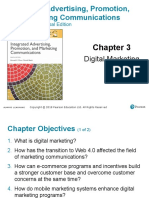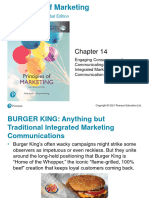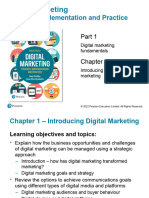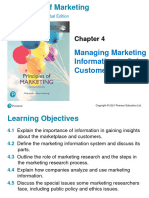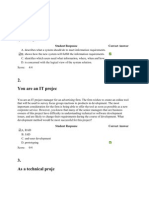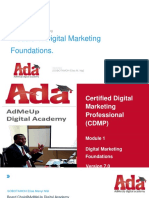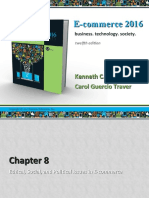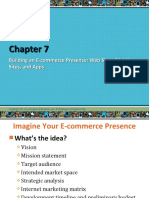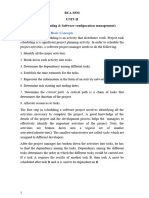Laudon-Traver Ec12 PPT CH04
Laudon-Traver Ec12 PPT CH04
Uploaded by
Quỳnh Lê NhưCopyright:
Available Formats
Laudon-Traver Ec12 PPT CH04
Laudon-Traver Ec12 PPT CH04
Uploaded by
Quỳnh Lê NhưOriginal Title
Copyright
Available Formats
Share this document
Did you find this document useful?
Is this content inappropriate?
Copyright:
Available Formats
Laudon-Traver Ec12 PPT CH04
Laudon-Traver Ec12 PPT CH04
Uploaded by
Quỳnh Lê NhưCopyright:
Available Formats
E-commerce 2016
business. technology. society.
twelfth edition
global edition
Kenneth C. Laudon
Carol Guercio Traver
Copyright © 2017 Pearson Education Ltd.
Chapter 4
Building an E-commerce Presence
Copyright © 2017 Pearson Education Ltd.
Class Discussion
Thegioididong.com
Mục tiêu của thế giới di động khi thiết kế trang web
TMĐT của doanh nghiệp mình?
Những cân nhắc trong việc thiết kế website của
thegioididong?
Thế giới di động đã làm gì để đáp ứng nhu cầu của
người dùng thiết bị di động?
Copyright © 2017 Pearson Education, Inc. Slide 3-4
Imagine Your E-commerce Presence
What’s the idea? Vision includes:
Mission statement
Target audience
Intended market space
Strategic analysis
Marketing matrix
Development timeline
Preliminary budget
Copyright © 2017 Pearson Education Ltd. Slide 4-5
Imagine Your E-commerce Presence (cont.)
Where’s the money?
Business model(s):
Portal, e-tailer, content provider, transaction broker,
market creator, service provider, community
provider (social networks)
Revenue model(s):
Advertising, subscriptions, transaction fees, sales,
and affiliate revenue
Copyright © 2017 Pearson Education Ltd. Slide 4-6
Imagine Your E-commerce Presence (cont.)
Who and where is the target audience?
Describing your audience
Demographics
Age, gender, income, location
Behavior patterns (lifestyle)
Consumption patterns (purchasing habits)
Digital usage patterns
Content creation patterns (blogs, Facebook)
Buyer personas
Copyright © 2017 Pearson Education Ltd. Slide 4-7
Imagine Your E-commerce Presence (cont.)
Characterize the marketplace
Demographics
Size, growth, changes
Structure
Competitors
Suppliers
Substitute products
Where is the content coming from?
Static or dynamic?
Copyright © 2017 Pearson Education Ltd. Slide 4-8
Imagine Your E-commerce Presence (cont.)
Know yourself—SWOT analysis
Develop an e-commerce presence map
Develop a timeline: Milestones
How much will this cost?
Simple Web sites: up to $5000
Small Web start-up: $25,000 to $50,000
Large corporate site: $100,000+ to millions
Copyright © 2017 Pearson Education Ltd. Slide 4-9
SWOT Analysis
Figure 4.1, page 193
Copyright © 2017 Pearson Education Ltd. Slide 4-10
E-commerce Presence Map
Figure 4.2, page 194
Copyright © 2017 Pearson Education Ltd. Slide 4-11
Building an E-commerce Site:
A Systematic Approach
Most important management
challenges:
Developing a clear understanding of
business objectives
Knowing how to choose the right
technology to achieve those objectives
Copyright © 2017 Pearson Education Ltd. Slide 4-12
Pieces of the Site-Building Puzzle
Main areas where you will need to make
decisions:
Human resources and organizational
capabilities
Creating team with skill set needed to build and
manage a successful site
Hardware/software
Telecommunications
Site design
Copyright © 2017 Pearson Education Ltd. Slide 4-13
The Systems Development Life Cycle
Methodology for understanding business
objectives of a system and designing an
appropriate solution
Five major steps:
Systems analysis/planning
Systems design
Building the system
Testing
Implementation
Copyright © 2017 Pearson Education Ltd. Slide 4-14
Web Site Systems Development Life Cycle
Figure 4.5, Page 198
Copyright © 2017 Pearson Education Ltd. Slide 4-15
System Analysis/Planning
Business objectives:
List of capabilities you want your site to have
System functionalities:
List of information system capabilities needed
to achieve business objectives
Information requirements:
Information elements that system must produce
in order to achieve business objectives
Copyright © 2017 Pearson Education Ltd. Slide 4-16
Table 4.2, page 199
Copyright © 2017 Pearson Education Ltd. Slide 4-17
Systems Design:
Hardware and Software Platforms
System design specification:
Description of main components of a system and their
relationship to one another
Two components of system design:
Logical design
Data flow diagrams, processing functions, databases
Physical design
Specifies actual physical, software components, models, and
so on
Copyright © 2017 Pearson Education Ltd. Slide 4-18
Logical Design for a Simple Web Site
Figure 4.6 (a), Page 201
Copyright © 2017 Pearson Education Ltd. Slide 4-19
Physical Design for a Simple Web Site
Figure 4.6 (b), Page 201
Copyright © 2017 Pearson Education Ltd. Slide 4-20
Build/Host Your Own vs. Outsourcing
Outsourcing: Hiring vendors to provide
services involved in building site
Build own vs. outsourcing:
Build your own requires team with diverse skill set; choice of
software tools; both risks and possible benefits
Host own vs. outsourcing
Hosting: Hosting company responsible for ensuring site is
accessible 24/7, for monthly fee
Co-location: Firm purchases or leases Web server (with control
over its operation), but server is located at vendor’s facility
Copyright © 2017 Pearson Education Ltd. Slide 4-21
Choices in Building and Hosting
Figure 4.7 Page 202
Copyright © 2017 Pearson Education Ltd. Slide 4-22
Testing, Implementation, and
Testing
Maintenance
Unit testing
System testing
Acceptance testing
A/B testing (split testing)
Multivariate testing
Implementation and maintenance:
Maintenance is ongoing
Maintenance costs: Similar to development costs
Benchmarking
Copyright © 2017 Pearson Education Ltd. Slide 4-24
Factors in Web Site Optimization
Figure 4.10, Page 209
Copyright © 2017 Pearson Education Ltd. Slide 4-25
Simple vs. Multi-tiered
Web Site Architecture
System architecture
Arrangement of software, machinery, and tasks in an
information system needed to achieve a specific
functionality
Two-tier
Web server and database server
Multi-tier
Web application servers
Backend, legacy databases
Copyright © 2017 Pearson Education Ltd. Slide 4-26
Two-Tier E-commerce Architecture
Figure 4.11(a), Page 211
Copyright © 2017 Pearson Education Ltd. Slide 4-27
Multi-Tier E-commerce Architecture
Figure 4.11(b), Page 211
Copyright © 2017 Pearson Education Ltd. Slide 4-28
Web Server Software
Apache
Leading Web server software
Works with UNIX, Linux operating systems
Reliable, stable, part of open software community
Microsoft’s Internet Information Server
(IIS)
Second major Web server software
Windows-based
Integrated, easy-to-use
Copyright © 2017 Pearson Education Ltd. Slide 4-29
Table 4.4, Page 212
Copyright © 2017 Pearson Education Ltd. Slide 4-30
Site Management Tools
Basic tools
Included in all Web servers
Verify that links on pages are still valid
Identify orphan files
Third-party software for advanced
management
Monitor customer purchases, marketing campaign
effectiveness, and so on
Webtrends Analytics 10
Copyright © 2017 Pearson Education Ltd. Slide 4-31
Dynamic Page Generation Tools
Dynamic page generation:
Contents stored in database and fetched when needed
Common tools:
CGI, ASP, JSP, ODBC, JDBC
Advantages
Lowers menu costs
Permits easy online market segmentation
Enables cost-free price discrimination
Enables content management system (CMS)
Copyright © 2017 Pearson Education Ltd. Slide 4-32
Application Servers
Web application servers:
Provide specific business functionality required
for a Web site
Type of middleware
Isolate business applications from Web servers and
databases
Single-function applications being replaced by
integrated software tools that combine all
functionality needed for e-commerce site
Copyright © 2017 Pearson Education Ltd. Slide 4-33
E-commerce Merchant Server Software
Provides basic functionality for sales
Online catalog
List of products available on Web site
Shopping cart
Allows shoppers to set aside, review, edit selections,
and then make purchase
Credit card processing
Typically works in conjunction with shopping cart
Verifies card and puts through credit to company’s
account at checkout
Copyright © 2017 Pearson Education Ltd. Slide 4-34
Merchant Server Software Packages
Integrated environment that includes most of
functionality needed
Key factors in selecting a package
Functionality
Support for different business models, including (m-commerce)
Business process modeling tools
Visual site management and reporting
Performance and scalability
Connectivity to existing business systems
Compliance with standards
Global and multicultural capability
Local sales tax and shipping rules
Copyright © 2017 Pearson Education Ltd. Slide 4-35
Web Services and Open-Source Options
Options for small firms
Hosted e-commerce sites
Offer site building tools and templates
Example: Yahoo Stores Basic
Open-source merchant server software
Enables you to build truly custom sites
Requires programmer with expertise, time
Copyright © 2017 Pearson Education Ltd. Slide 4-36
Choosing Hardware
Hardware platform:
Underlying computing equipment needed for
e-commerce functionality
Objective:
Enough platform capacity to meet peak demand
without wasting money
Important to understand the factors that
affect speed, capacity, and scalability of a
site
Copyright © 2017 Pearson Education Ltd. Slide 4-37
Right-Sizing Your Hardware Platform:
The Demand Side
Customer demand:
Most important factor affecting speed of site
Factors in overall demand:
Number of simultaneous users in peak periods
Nature of customer requests (user profile)
Type of content (dynamic vs. static Web pages)
Required security
Number of items in inventory
Number of page requests
Speed of legacy applications
Copyright © 2017 Pearson Education Ltd. Slide 4-38
Right-Sizing Your Hardware Platform:
The Supply Side
Scalability:
Ability of site to increase in size as demand warrants
Ways to scale hardware:
Vertically
Increase processing power of individual components
Horizontally
Employ multiple computers to share workload
Improve processing architecture
Outsource to cloud service, CDN
Copyright © 2017 Pearson Education Ltd. Slide 4-39
Table 4.8, Page 223
Copyright © 2017 Pearson Education Ltd. Slide 4-40
Table 4.9, Page 224
Copyright © 2017 Pearson Education Ltd. Slide 4-41
Other E-commerce Site Tools
Web site design: Basic business considerations
Enabling customers to find and buy what they need
Tools for Web site optimization
Search engine placement
Metatags, titles, content
Identify market niches, localize site
Offer expertise
Links
Buy ads
Local e-commerce
Copyright © 2017 Pearson Education Ltd. Slide 4-42
Table 4.10, Page 225
Copyright © 2017 Pearson Education Ltd. Slide 4-43
Table 4.11, Page 226
Copyright © 2017 Pearson Education Ltd. Slide 4-44
Tools for Interactivity and
Active Content
CGI (Common Gateway Interface)
ASP (Active Server Pages)/ASP.NET
Java, JSP, and JavaScript
ActiveX and VBScript
ColdFusion
PHP, Ruby on Rails, Django
Other design elements:
Widgets, mashups
Copyright © 2017 Pearson Education Ltd. Slide 4-45
Personalization Tools
Personalization
Ability to treat people based on personal
qualities and prior history with site
Customization
Ability to change the product to better fit the
needs of the customer
Cookies
Primary method to achieve personalization
Copyright © 2017 Pearson Education Ltd. Slide 4-46
The Information Policy Set
Privacy policy
Set of public statements declaring how site will
treat customers’ personal information that is
gathered by site
Accessibility rules
Set of design objectives that ensure disabled
users can effectively access site
Copyright © 2017 Pearson Education Ltd. Slide 4-47
Insight on Technology: Class Discussion
Designing for Accessibility
Why might some merchants be reluctant to make
their Web sites accessible to the disabled?
How can Web sites be made more accessible?
Should all Web sites be required by law to provide
“equivalent alternatives” for visual and sound
content?
What additional accessibility problems do mobile
devices pose?
Copyright © 2017 Pearson Education, Inc. Slide 3-48
Developing a Mobile Web Site and
Building Mobile Applications
Types of m-commerce software
Mobile Web site
Responsive Web design
Mobile Web app
Native app
Hybrid app
Runs inside native container
App distribution
Based on HTML5, CSS, Javascript
Copyright © 2017 Pearson Education Ltd. Slide 4-49
Planning and Building a Mobile
Presence
Identify business objectives, system
functionality, and information
requirements
Choice:
Mobile Web site or mobile Web app
Less expensive
Native app
Can use device hardware, available offline
Copyright © 2017 Pearson Education Ltd. Slide 4-50
Table 4.13, Page 237
Copyright © 2017 Pearson Education Ltd. Slide 4-51
Mobile Presence Design Considerations
Platform constraints
Graphics, file sizes
Mobile first design
Desktop Web site design after mobile design
Responsive Web design (RWD)
CSS site adjusts layout of site according to device screen
resolutions
Adaptive Web design (AWD)
Server delivers different templates or versions of site
optimized for device
Copyright © 2017 Pearson Education Ltd. Slide 4-52
Cross-Platform Mobile App
Development Tools
Objective C, Java
Low cost, open-source alternatives
Appery.io
Codiqa
PhoneGap
MoSync
Appcelerator
Copyright © 2017 Pearson Education Ltd. Slide 4-53
Performance and Cost Considerations
Mobile first design: Most efficient
Mobile Web site:
Resizing existing Web site for mobile access is least
expensive
Mobile Web app:
Can utilize browser API
Native app:
Most expensive; requires more programming
Copyright © 2017 Pearson Education Ltd. Slide 4-54
Insight on Technology: Class Discussion
Building a Mobile Presence
What are the key differences between user
experience on a Web site and on a mobile
device?
Why would a mobile Web site or app from the
same merchant need different content or
functionality?
In which cases would a merchant want to
develop a mobile app over a mobile Web site?
Copyright © 2017 Pearson Education, Inc. Slide 3-55
You might also like
- Instagram User AnalyticsDocument7 pagesInstagram User AnalyticsHarsh Veer100% (1)
- Digital Marketing Strategy Development - Marketing MixDocument55 pagesDigital Marketing Strategy Development - Marketing MixMai Sang NguyễnNo ratings yet
- Chapter 10Document14 pagesChapter 10Jiaway Teh100% (1)
- Sixteenth Edition: The Revolution Is Just BeginningDocument30 pagesSixteenth Edition: The Revolution Is Just BeginningMoen 693No ratings yet
- Week 13.. - Laudon-Traver - Ec15 - PPT - ch12 - PPTDocument58 pagesWeek 13.. - Laudon-Traver - Ec15 - PPT - ch12 - PPTmuniraNo ratings yet
- Integrated Advertising, Promotion, and Marketing CommunicationsDocument27 pagesIntegrated Advertising, Promotion, and Marketing CommunicationsAhmed Q100% (1)
- Chapter 4 SummaryDocument3 pagesChapter 4 Summaryeudamnbored100% (1)
- G8020-90005 5800 5900 Service Manual Draft 0 - 1Document246 pagesG8020-90005 5800 5900 Service Manual Draft 0 - 1andri purnomo100% (1)
- Return STO - Stock Transfer Order in Sap S4 HANADocument11 pagesReturn STO - Stock Transfer Order in Sap S4 HANAParvati100% (1)
- Laudon-Traver Ec10 PPT Ch02Document42 pagesLaudon-Traver Ec10 PPT Ch02Ali Abdul MohdNo ratings yet
- 4 - Advertising Management - PART 1 - 3Document29 pages4 - Advertising Management - PART 1 - 3Khondoker MesbhaNo ratings yet
- Chapter 02Document14 pagesChapter 02Piyush SethNo ratings yet
- E-Commerce 2019: Business. Technology. Society.: Fifteenth EditionDocument45 pagesE-Commerce 2019: Business. Technology. Society.: Fifteenth EditionAhmed Deq MuseNo ratings yet
- Laudon-Traver Ec16 PPT Ch09 AccessibleDocument50 pagesLaudon-Traver Ec16 PPT Ch09 AccessibleThao PhuongNo ratings yet
- Introduction To E-Business and E-CommerceDocument22 pagesIntroduction To E-Business and E-CommerceSakibMDShafiuddinNo ratings yet
- E-Commerce 2014: Kenneth C. Laudon Carol Guercio TraverDocument27 pagesE-Commerce 2014: Kenneth C. Laudon Carol Guercio Travervivek gupta100% (1)
- SYLLABUS Introduction To Business LawDocument6 pagesSYLLABUS Introduction To Business LawARMATNo ratings yet
- Laudon-Traver Ec16 PPT ch02 AccessibleDocument42 pagesLaudon-Traver Ec16 PPT ch02 AccessibleconstantinetenebreNo ratings yet
- Change Management 2011Document14 pagesChange Management 2011শাওন ইসতিয়াকNo ratings yet
- DM ch.2Document57 pagesDM ch.2Tala MomaniNo ratings yet
- Kolkata Knight Riders IMC CampaignDocument34 pagesKolkata Knight Riders IMC CampaignRohit WadgeNo ratings yet
- Laudon-Traver Ec16 PPT ch11 AccessibleDocument31 pagesLaudon-Traver Ec16 PPT ch11 Accessibleanhnph21No ratings yet
- Chapter 18Document42 pagesChapter 18wuay1991No ratings yet
- Principles of Marketing: Eighteenth Edition, Global EditionDocument37 pagesPrinciples of Marketing: Eighteenth Edition, Global EditionGAIL DOMINIQUE OCAMPONo ratings yet
- AgoraDocument24 pagesAgoraAiman Jan Chowdhury100% (1)
- Laudon-Traver Ec10 PPT ch07Document47 pagesLaudon-Traver Ec10 PPT ch07nilanjan_kar_2No ratings yet
- Week 11 & 12 - Laudon-Traver - Ec15 - PPT - ch08 - PPTDocument46 pagesWeek 11 & 12 - Laudon-Traver - Ec15 - PPT - ch08 - PPTmuniraNo ratings yet
- CH 03 PPTDocument32 pagesCH 03 PPTshajibayliNo ratings yet
- MPP Scheme of Work 2022-2023 Semester 2Document4 pagesMPP Scheme of Work 2022-2023 Semester 2Nhi SionNo ratings yet
- Chapter # 03 (E-Business Infrastructure)Document37 pagesChapter # 03 (E-Business Infrastructure)Fatima Khan100% (2)
- Laudon-Traver Ec10 PPT Ch01Document29 pagesLaudon-Traver Ec10 PPT Ch01Khurram Adeel ShaikhNo ratings yet
- Laudon-Traver Ec17 PPT Ch01 AccessibleDocument29 pagesLaudon-Traver Ec17 PPT Ch01 AccessibleAminul RanaNo ratings yet
- Lecture Slides - Week 01Document49 pagesLecture Slides - Week 01Muhammad SufianNo ratings yet
- Ad and IMC Chapter 4 NotesDocument85 pagesAd and IMC Chapter 4 Notesteagan.f02No ratings yet
- Social Networks, Auctions, and PortalsDocument37 pagesSocial Networks, Auctions, and PortalsHenry Zegarra RodriguezNo ratings yet
- Kotler Pom18 PPT 14Document38 pagesKotler Pom18 PPT 1412B1-01-Bảo AnNo ratings yet
- Management Information Systems: Managing The Digital Firm, 12e Authors: Kenneth C. Laudon and Jane P. LaudonDocument40 pagesManagement Information Systems: Managing The Digital Firm, 12e Authors: Kenneth C. Laudon and Jane P. Laudonhello everyoneNo ratings yet
- Laudon Traver Ec16 PPT Ch07 Accessible 26022023 080500pmDocument46 pagesLaudon Traver Ec16 PPT Ch07 Accessible 26022023 080500pmGreson JamesNo ratings yet
- Turban Ec2012 PP 01Document36 pagesTurban Ec2012 PP 01FatinAzizNo ratings yet
- pp01Document31 pagespp01cefidawiNo ratings yet
- Kotler Pom18 PPT 04.ppt StsDocument18 pagesKotler Pom18 PPT 04.ppt Stskhangvhse181669No ratings yet
- Chapter 1Document28 pagesChapter 1Visha KupusamyNo ratings yet
- Chap.#13 QuizDocument11 pagesChap.#13 QuizShanta BhattaraiNo ratings yet
- Laudon Traver Ec16 PPT Ch07 Accessible 04102022 025213pmDocument30 pagesLaudon Traver Ec16 PPT Ch07 Accessible 04102022 025213pmnimra nazimNo ratings yet
- CDMP7.1 Slides DigitalMarketingFoundationsDocument119 pagesCDMP7.1 Slides DigitalMarketingFoundationsAbdoul karimNo ratings yet
- Turban 04 RevisedDocument51 pagesTurban 04 Revisedapi-236400138No ratings yet
- Chapter 8Document39 pagesChapter 8Phương UyênNo ratings yet
- Laudon-Traver Ec15 PPT Ch01-Rev AccessiblePPT-ctDocument29 pagesLaudon-Traver Ec15 PPT Ch01-Rev AccessiblePPT-ctKhleel IfranjiNo ratings yet
- Kotler Pom18 PPT 19Document40 pagesKotler Pom18 PPT 19JevanNo ratings yet
- 01 Overview of Electronic CommerceDocument31 pages01 Overview of Electronic CommerceOANH NGUYỄN TRỊNH HOÀNGNo ratings yet
- Retail Management: A Strategic Approach: Web, Nonstore-Based, and Other Forms of Nontraditional RetailingDocument18 pagesRetail Management: A Strategic Approach: Web, Nonstore-Based, and Other Forms of Nontraditional RetailingThenappan GanesenNo ratings yet
- Kotler Pom18 PPT 01.ppt StsDocument44 pagesKotler Pom18 PPT 01.ppt Stskhangvhse181669No ratings yet
- EC Chapter 1Document31 pagesEC Chapter 1RahafNo ratings yet
- Kotler Pom16e Inppt 05Document48 pagesKotler Pom16e Inppt 05gosaye desalegn100% (2)
- Kotler Pom CW PPT Exp Ch02Document15 pagesKotler Pom CW PPT Exp Ch02Abhi KeshwaniNo ratings yet
- Kotler Pom18 PPT 10Document31 pagesKotler Pom18 PPT 10maryamshoukat364100% (1)
- Building An E-Commerce Presence: Web Sites, Mobile Sites, and AppsDocument48 pagesBuilding An E-Commerce Presence: Web Sites, Mobile Sites, and AppsLeon YapNo ratings yet
- IS-346 Unit-4 (ch04)Document36 pagesIS-346 Unit-4 (ch04)Abrar Al-OtaibiNo ratings yet
- ch04 - EcDocument27 pagesch04 - Eczakaria alkindiNo ratings yet
- E-Commerce: Business. Technology. SocietyDocument50 pagesE-Commerce: Business. Technology. SocietyAMNA NAVEEDNo ratings yet
- Chapter 3Document43 pagesChapter 3ohoudhasan08No ratings yet
- E Commerce Ch04Document50 pagesE Commerce Ch04Joseph Kandalaft100% (1)
- Digital Transformation with Dataverse for Teams: Become a citizen developer and lead the digital transformation wave with Microsoft Teams and Power PlatformFrom EverandDigital Transformation with Dataverse for Teams: Become a citizen developer and lead the digital transformation wave with Microsoft Teams and Power PlatformNo ratings yet
- ITB Information Technology For BusinessDocument18 pagesITB Information Technology For BusinessShreyas TaNo ratings yet
- Different Python Interview ProgramsDocument10 pagesDifferent Python Interview ProgramsAKSHAY WADITKENo ratings yet
- BTC - Autopilot - Method - MAKE - 700$-800$ - PER - WEEK2Document4 pagesBTC - Autopilot - Method - MAKE - 700$-800$ - PER - WEEK2DESMOND LENSNo ratings yet
- (EE-335) - Power Gen, Trans and Dist Lab SyllabusDocument20 pages(EE-335) - Power Gen, Trans and Dist Lab SyllabusAbeer SohailNo ratings yet
- User Manual-Sx Series IP CameraDocument52 pagesUser Manual-Sx Series IP CameraCarlos SaldanaNo ratings yet
- Layer 2 SecurityDocument31 pagesLayer 2 SecurityNgọc HuyNo ratings yet
- Data Structures LaboratoryDocument50 pagesData Structures LaboratorySiriNo ratings yet
- Power Pro Quick Start GuideDocument1 pagePower Pro Quick Start Guidepoloksaha210No ratings yet
- ELEC3644 Lab3 2023Document4 pagesELEC3644 Lab3 2023KT ChanNo ratings yet
- Portfolio - Ramadhan Khansa AkbariDocument39 pagesPortfolio - Ramadhan Khansa AkbarialuhmosakmasikNo ratings yet
- How Mlops Helps Build Better Machine Learning ModelsDocument4 pagesHow Mlops Helps Build Better Machine Learning ModelsHanu TiwariNo ratings yet
- GO16 - WD - CH03 - GRADER - 3G - AS - Environmental Newsletter and Research Paper 1.3 - InstructionsDocument3 pagesGO16 - WD - CH03 - GRADER - 3G - AS - Environmental Newsletter and Research Paper 1.3 - InstructionsPearl AngelaNo ratings yet
- How To A Create TableDocument24 pagesHow To A Create Tablebhuvan9032No ratings yet
- Syntax CheatsheetDocument4 pagesSyntax CheatsheetPranay BagdeNo ratings yet
- Practical - 2Document3 pagesPractical - 2Awaish MemonNo ratings yet
- Cs Xii Practical FileDocument51 pagesCs Xii Practical Filesandhya kumariNo ratings yet
- All About Computer Practice Hindi PDFDocument42 pagesAll About Computer Practice Hindi PDFRaj ChaudharyNo ratings yet
- GIS A Computing PerspectiveDocument2 pagesGIS A Computing PerspectiveErika GuevaraNo ratings yet
- Experiment 7: Avi Ajmera N203 MBA Tech CS (A) 70471118003Document11 pagesExperiment 7: Avi Ajmera N203 MBA Tech CS (A) 70471118003Avi AjmeraNo ratings yet
- Freshers Jobs 30 Jan 2024Document9 pagesFreshers Jobs 30 Jan 2024whiteyaksha24No ratings yet
- Name: Purushotham E-Mail: Purushothamthota635 Gmail Com Phone:+91-9705725472 Summary of ExperienceDocument3 pagesName: Purushotham E-Mail: Purushothamthota635 Gmail Com Phone:+91-9705725472 Summary of ExperiencepurushothamNo ratings yet
- Create A New Coordinate System - PolygaDocument3 pagesCreate A New Coordinate System - PolygabtkmouradNo ratings yet
- ME83691 All Important Units Question Without SolvedDocument15 pagesME83691 All Important Units Question Without SolvedGanapathy TNo ratings yet
- Response SummaryDocument12 pagesResponse SummarySakthyNo ratings yet
- Supplier Librarian: Brings Books TDocument3 pagesSupplier Librarian: Brings Books TGerald SimzNo ratings yet
- Unit-Ii Bca SPMDocument28 pagesUnit-Ii Bca SPMpranjalsharma8542dNo ratings yet
- Product DissectionDocument8 pagesProduct Dissectionanjalibathula23No ratings yet





